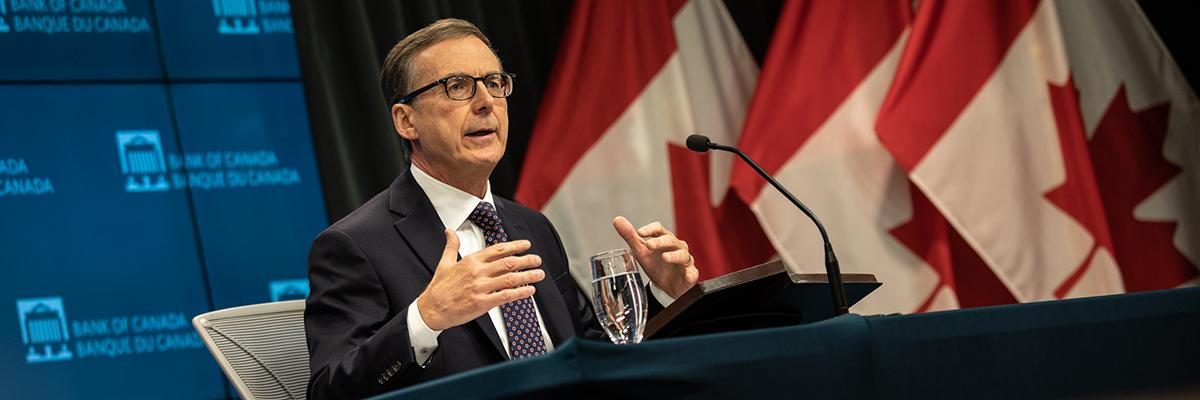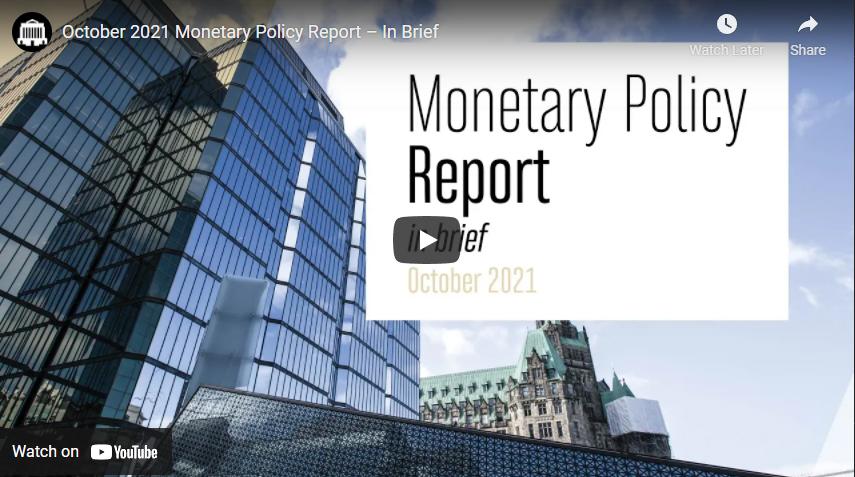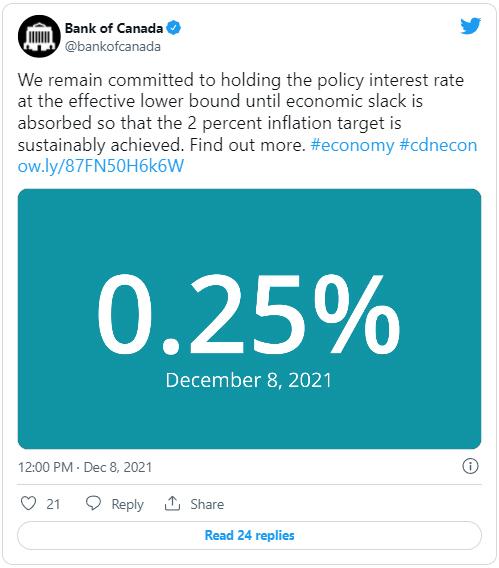
Monetary policy
The Canadian economy continued to recover from the effects of the COVID‑19 pandemic in 2021. As vaccination rates increased and health restrictions eased, growth—including in hard-to-distance services sectors—became more widespread.
The labour market also made impressive gains, and the very uneven impacts of the pandemic on the employment of women and youth were largely reversed. By the end of the year, employment had returned to its pre-pandemic level.
While the recovery was strong in 2021, reopening the economy brought new challenges. Disruptions to global supply chains pushed up the prices of many goods. Combined with higher energy and food prices, this contributed to rising inflation in Canada and in other countries. These supply disruptions also restrained economic activity.
Uncertainty remained heightened at the end of 2021. The spread of new variants of the virus continued to prolong the pandemic. The outlook for gross domestic product (GDP) and potential output remained difficult to assess due to:
- supply disruptions
- ongoing structural changes, such as digitalization
Supporting the pandemic recovery
The Bank took several important steps in 2021 to support the pandemic recovery.
Tracking economic conditions in the second year of the pandemic
Global economic activity continued to improve through 2021, but progress remained choppy and uneven. By the end of the year, the recovery had a firmer foundation in advanced economies than it did in emerging-market economies, mainly because of higher vaccination rates and more stimulative policy measures.
Strong demand for goods—which bolstered global manufacturing and trade—supported global growth. However, transportation bottlenecks and shortages of semiconductors and construction materials limited production in some sectors that are important for Canadian exports, such as motor vehicles and parts and construction.

https://www.youtube.com/watch?v=fyrwPdkWQbs
The rebound of the Canadian economy that began in the second half of 2020 continued into 2021. Progress stalled, however, in the second quarter of 2021 with the reintroduction of measures to contain the spread of the virus coupled with supply chain issues and a slowing in the housing market.
As the virus receded and vaccination rates rose rapidly, public health restrictions were eased and growth was robust through the second half of the year.
The Canadian labour market recovered strongly, and by the end of the year:
- the unemployment rate was approaching where it had been before the pandemic
- employment returned to its pre-pandemic level
Against this backdrop, businesses reported increased challenges filling vacant jobs, especially for skilled trades and digital workers. In many hard-hit service industries, employers also struggled to find workers quickly enough to meet the surge in demand as the economy reopened.
WATCH: In a virtual speech before @SBofT, Deputy Governor Toni Gravelle discusses supply shortages and the current rate of inflation and shares insight on yesterday’s monetary policy decision. #cdnecon December 9, 2021

https://twitter.com/bankofcanada/status/1469004447686742026
Understanding the factors pushing inflation above target
Consumer price index inflation (CPI) rose above the Bank’s target range. Four key factors contributed to rising prices:
- base-year effects1
- increased prices for goods, including food, as a result of global and domestic supply disruptions coupled with high demand
- stronger energy prices
- a rebound in demand in hard-to-distance sectors as pandemic restrictions were eased
In response to the rise in inflation, near-term inflation expectations picked up, but long-term inflation expectations remained well anchored. This anchoring is critical to monetary policy because the economic decisions people and businesses make today are influenced by their expectations for how prices are likely to evolve in the future. These decisions in turn feed into the actual rate of price increases.
| Achievement of target for consumer price index (CPI) inflation | ||||||
| Key indicators | Reference level | 2017 | 2018 | 2019 | 2020 | 2021 |
| CPI inflation (%) | 2.0 | 1.6 | 2.3 | 1.9 | 0.7 | 3.4 |
| Average CPI inflation since 2001 (%) | 1.9 | |||||
| Inflation expectations at a 10-year horizon (%) | 2.0 | 2.0 | 2.0 | 2.0 | 2.0 | 2.0 |
Providing stimulus through monetary policy
Overall, the economy required considerable monetary policy support in 2021. The Bank therefore held the policy interest rate at the effective lower bound—0.25%—and remained committed to keeping it there until economic slack is absorbed so that the 2% inflation target is sustainably achieved.
Through the year, the Bank adjusted its quantitative easing (QE) program. It reduced the amount of net new purchases of Government of Canada bonds in April and again in July, before ending QE in late October. The Bank then entered a reinvestment phase and signalled that it would continue purchasing government bonds to replace maturing ones to keep its overall holdings roughly constant. The Bank will continue this reinvestment phase at least until the policy rate begins to rise.
We remain committed to holding the policy interest rate at the effective lower bound until economic slack is absorbed so that the 2 percent inflation target is sustainably achieved. Find out more. #economy #cdnecon http://ow.ly/87FN50H6k6W December 8, 2021

https://twitter.com/bankofcanada/status/1468626522651213826
Supporting the Bank’s monetary policy function
Timely and thorough analysis supported monetary policy decisions throughout the year. Bank staff continued to assess the pandemic’s impact on the global and Canadian economies.
Despite the highly complex forces affecting total supply and demand, the Bank correctly anticipated that GDP growth would slow in the first half of 2021 before picking up in the second half of the year. However, the rise in inflation in the second half was greater than expected.
Staff leveraged insights from new data sources and adjusted the questions in Bank surveys to better inform economic projections and policy decisions.2 Still, the uncertainty surrounding both global and domestic economic forecasts remained unusually high. This was largely due to the pandemic’s unpredictability and the unprecedented nature of the associated economic shock. While some of the disruptions were expected, others—particularly the extent and duration of supply disruptions—were significantly more pronounced than had been anticipated.
Bank staff developed a comprehensive framework to assess labour market slack; this tool applies directly to the ongoing economic recovery from the pandemic.3 The framework uses a detailed approach that can identify important areas of weakness and strength in the labour market.
ICYMI: Deputy Governor Lawrence Schembri explains why we are developing new tools to measure the health of the labour market. #cdnecon http://ow.ly/NGoJ50GPV6SNovember 17, 2021

https://twitter.com/bankofcanada/status/1461016385363001347
Staff also used high-frequency, transaction-level data to better understand consumers’ payment habits during the pandemic.4 Such data helped the Bank accurately forecast the strength of the rebound in the second half of the year.
In addition, staff completed analysis of macroeconomic climate transition scenarios as part of the Bank’s pilot project with Canadian financial institutions. The Bank is among the first central banks to combine climate-economy models with macroeconomic models to assess transition risks.
Renewing the Bank’s monetary policy framework
Following a comprehensive review and consultation process, the Bank renewed its monetary policy agreement with the federal government in 2021.
Looking forward
In 2022, the Bank will focus on monitoring the recovery in supply and demand and on understanding the medium- to long-term economic consequences of the pandemic. In addition, the Bank will:
- continue to improve current macroeconomic models, including through a richer characterization of labour markets and more realistic specifications for expectations.
- extend new forecasting tools using non-traditional data sources.
- improve surveys and outreach to better understand the changing economy. In particular, the Bank will undertake a new online business survey and work on enhancing its understanding of the Indigenous economy by examining characteristics of and conditions within the Indigenous business sector.
- continue to explore the effects of digitalization, automation and adoption of advanced technologies and their implications for the Canadian economy, with a particular focus on labour markets and productivity.
- assess the impact of both physical risks associated with climate change and risks from a climate-related transition to a low-carbon economy.
- 1. CPI inflation is measured by comparing the price of the CPI basket today with its price (or “base”) a year ago. This means that a large movement in the prices of items in the basket causes volatility: inflation moves in one direction at first and then reverses direction a year later. This reversal is known as the base-year effect. For more information, see the Bank’s explainer on the consumer price index.[←]
- 2. For example, a new database from Indeed provided information on how online job postings linked to digital technologies evolved during the pandemic (reported in the Bank’s July Monetary Policy Report). New features were also added to the Canadian Survey of Consumer Expectations, including follow-up interviews to better understand inflation expectations and the health of the labour market. In addition, staff developed a new online business survey (the Business Leaders’ Pulse) that reaches a broad set of businesses to provide timely information on business conditions and expectations.[←]
- 3. E. Ens, L. Savoie-Chabot, K. See and S. L. Wee, “Assessing Labour Market Slack for Monetary Policy,” Bank of Canada Staff Discussion Paper No. 2021‑15 (October 2021).[←]
- 4. T. Dahlhaus and A. Welte, “Payment Habits During COVID‑19: Evidence from High-Frequency Transaction Data,” Bank of Canada Staff Working Paper No. 2021‑43 (September 2021).[←]